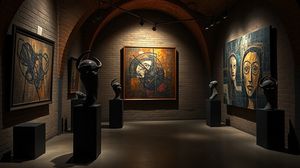
Nestled within the historical confines of University College London, the Wilkins Building Cloisters are a serene and architecturally fascinating part of the famed institution. Designed by the renowned architect William Wilkins in the early 19th century, the building and its cloisters reflect the classical style characteristic of that era.
The Wilkins Building is situated in the heart of Bloomsbury, an area bustling with academic life and rich history. The cloisters provide a peaceful respite from the energy of Gower Street and serve as a contemplative space surrounded by the university's various departments.
One of the most interesting aspects of the Wilkins Building is its classic portico entrance, which is supported by grand Corinthian columns, adding to the building's majestic appearance. This feature is part of what makes the building a striking presence on the university campus.
Inside the cloisters, you can find stunning stonework and detailed architectural features that highlight the sophistication of early 19th-century design. This makes the cloisters not just a place for quiet reflection, but also a destination for architecture enthusiasts.
The cloisters have played host to numerous events and gatherings for students and academics alike, making it not only a historical landmark but also a living part of the university's vibrant community. During these events, the corridors echo with conversations and debates, reflecting the intellectual spirit of UCL.

Making the Most of Your Visit:
If you're visiting during term time, try to go early in the morning. The Wilkins Building Cloisters are usually quieter then, allowing you to enjoy the serenity and architectural details without too many distractions from the bustling university life.
Keep an eye out for any temporary art exhibits or installations. The cloisters occasionally host exhibitions, showcasing works by UCL students and other artists, which adds an extra layer of cultural richness to your visit.
As you explore, notice the acoustics of the cloisters. The stonework provides a unique soundscape, making it a delightful spot for listening to someone practicing an instrument nearby. If you're lucky, you might catch the gentle notes of a student's music echoing through the hallways.
If you're interested in history and architecture, take the time to closely observe the Corinthian columns and other neoclassical elements. It's a mini lesson in 19th-century architecture right within a modern university setting, offering insights into the design preferences of that era.
The Bloomsbury area is rich in literary and academic history, so consider pairing your visit with a trip to Senate House or the British Library nearby. This gives a broader context to the intellectual atmosphere surrounding the cloisters.

Visiting Times & Costs:
The Wilkins Building Cloisters at University College London are open to the public, although access may be limited during university events or specific periods such as examinations. It is recommended to visit during UCL's term times for the most serene experience.
Generally, the cloisters are accessible during university opening hours, usually from early morning until early evening. However, these hours might change during holiday periods or special events.
There is no entrance fee to visit the Wilkins Building Cloisters, making it a cost-free attraction for visitors who wish to enjoy its architectural beauty and historical significance.
Accessibility for those with mobility impairments is generally good, as the cloisters are on ground level. However, some areas may have limited access due to the building's historical nature. Visitors requiring special assistance are advised to check availability of ramps or lifts within the university premises before their visit.

Address & Map:

Nearby:























